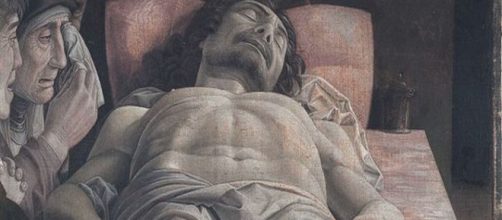You know those occasional tales of treasures found in people's closets or attic? Well, this story is a little like that. A report in the Art Newspaper on May 23 had all the marks of a great discovery: a curator at the Accademia Carrara in Bergamo said that an aging tempera painting dulled by varnish in the museum collection is by Renaissance painting great Andrea Mantegna. Nice story if true. Is it?
Proof positive
The painting, “Resurrection of Christ,” was long thought the work of Mantegna's studio assistants or maybe his son Francisco, who was his student.
One of the factors persuading the curator was the artist's name written in caps on the back of the picture. And to that I say, it wouldn't matter if the artist's Social Security number was inscribed in his own blood on the back of the painting, it's what's on the front that counts, and from that vantage point, my guess is that Mantegna had nothing to do with this thing.
False positive
Granted, I only have access to digital images of the painting, but the difference in style between this supposed Mantegna and all those proven his is so obvious that the curator's “discovery” seems absurd. I don't have a copyright-free image of the work in question to show you. I can only describe it. Using Mantegna's famed ”The Lamentation of a Dead Christ” as a baseline, instead of seeing his signature way of forming figures -- so sculptural that you imagine them carved from stone -- the figures in the curator's “discovery” are flat as paper dolls and so markedly two-dimensional that I question if it's even a Renaissance painting, let alone a Mantegna.
Written in stone
The rock-hard solidity of Mantegna's figure painting is so pronounced that the figures can come across as bloodless. He even went to the trouble of picturing the Bible tale of Judith and Holofernes in black and white to imitate the appearance of stone. At the same time, though, his figures appear wholly lifelike. Consider Judith's nurse helping her bag Holofernes' severed head. He set her legs apart as if to convey her strenuous effort to keep her balance while doing the dastardly deed.
Telltale signs
Mantegna couldn't help imitating stone sculpture. His art training had him study ancient relics and he told art historian Giorgio Vasari that the statues of ancient Greece and Rome were more perfect and composed of more beautiful parts than anything in nature.
Despite the mountain-hard look of his figures, Mantegna infused his painting with high emotion. Consider the brutal perspective in ”The Lamentation of a Dead Christ,” and note how the extreme foreshortening of the figure lends a harrowing air. The picture hailed as a Mantegna lacks not only his signature style, but also his gift of telling a story in a visceral way.


